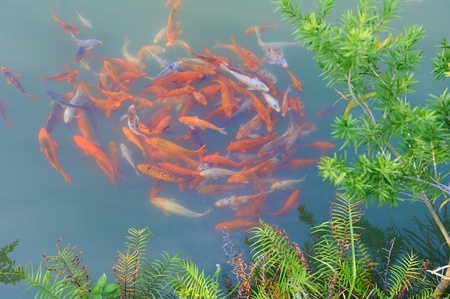The story in the Detroit Free Press about the koi wrangling event at the Belle Isle Aquarium, moving koi fish from their outdoor environs into their summer digs is a reminder to koi owners that preparations for winterization has arrived.
Koi are considered poikilothermic creatures—basically meaning they are cold blooded—so the ambient water temperature governs their basic functions. Cold water will not kill them, but it will slow them down to a crawl. One thing during that time remains vitally important no matter how slowly the koi move—water quality.
Not every koi fish enthusiast has facilities like Belle Isle. So for those having to contend with freezing temperatures, taking preventative and precautionary steps for your koi fish pond before the chill of winter can mean the difference in overall health and likely weakened immune system in the spring.
Here are some steps to take as part of your koi fish pond maintenance that will keep your koi safer (and potentially happier) during the winter.
Temperature Gauge
The website aquameds.com offers some insights into the best time to begin the winterization process and report that when water temperatures are at 50ºF for 10-14 days, it is time to drain the pipes and turn off your water pumps and waterfalls. Frozen water can lead to burst pipes, and as you want to keep the warmer water at the bottom, circulating it will result in a temperature drop— which can prove fatal.
Keep it Debris Free
One to two months out before the winter chill is expected, a good overall koi fish pond cleaning is advised. This is not an exact science as winter temperatures aren’t clockwork, but trends from previous years are a good place to consider starting.
Remove as much of the excess organic matter as you can from the surface and bottom (undigested food and leaves) using a net and/or vacuum to limit the harmful gases that will form when they decompose.
Make sure that you remove your tropical water plants if you have any, and do not feed your koi with temperatures below 50ºF.
Ice Management
Should ice be a seasonal reality, then make sure that a hole is maintained in it throughout the winter. Without gaseous exchange and allowing oxygen to circulate, the buildup of carbon dioxide and other gases will make it a toxic environment for the koi fish.
One important point to remember is that you shouldn’t smash the ice. The concussive force can harm or kill your koi.
There are various models of pond heaters (or de-icers) and aerators to ensure that ice doesn’t form completely over the pond’s surface. Enthusiasts have their own preferences as to which is more effective and which model or measure is better, so do some research and review the available options.
If cost is an issue, then an aerator is probably a better option as it will not be as expensive to run throughout the season. It is also recommended that the aerator be moved off the bottom and closer to the surface so as to not circulate the warmer water off the ponds bottom. If you are concerned for your koi’s well being, it can also be a good idea to have two systems on different circuits as a failsafe mechanism.
At Next Day Koi, we source our koi from some of the best farms around the world and have a large selection of koi fish available for sale. Coupled with a great selection of both sizes and types, we leverage our high volume of shipping through UPS to bring you some of the most competitive Next Day Air shipping rates in the industry, no matter what the season.
Contact us to find out how we can help get your pond stocked.


Hello: So I have a 1,000 gall. outdoor pond with a water fall, pond is about 12″ deep. I bought (5) 3″ Koi earlier this year in may, so their now about 6″-7″ in length. I’m needing to move the Koi indoors for the Winter due to the pond depth. I have an outdoor office off the back patio that I intended to move the fish, I can keep this room as warm or as cool as I would like. What is the proper size tank I should be utilizing & also, what filtering system should I be utilizing. I live in Lakewood Co. so timing for this is very near. I would appreciate any advice you can provide me. Thank you in advance !!
Hello Pat, thanks for shopping with us. The common standard we would observe is 100 gallons of water per 12″ fish. You can use this ratio to determine the size of tank that would best work for you. Here is a link to our other blog entries pertaining to your question :
https://nextdaykoi.com/koi-fish-facts/moving-koi-indoors-overwintering-inside/
https://nextdaykoi.com/koi-how-tos/keeping-koi-fish-indoors/
https://nextdaykoi.com/koi-fish-facts/keeping-koi-aquarium/
We hope that you will find them helpful. Let us know if the articles leave you with any questions.
[…] Winterizing your Outdoor Koi Fish Pond […]